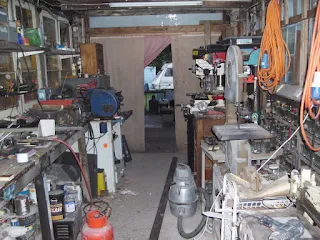
I'm not crazy about using integrated circuits, especially the really complex ones for which true understanding of how they work is impossible. The Mini-Circuits mixers are not, of course ICs, but for me they too have always had a whiff of the "black-box" about them. Thomas, OZ2CPU, pulls away the veil with this photo of the innards of an SBL-1.
I came across Thomas's very interesting
web site when I was installing in my QRSS beacon rig the SBL-1 mixer sent to me by Jim, AL7RV. That poor SBL had died suddenly during testing. Thomas alerted me to the cause of death: In his caption for the picture of the innards, he notes,
"I was unlucky to kill this one during my first transmit experiment. The IF input can NOT accept more than +20dBm audio level."
Joop and I have been discussing diode ring mixers, and I've been reading an article about them by Paul, NA5N. It looks to me like the designers of the SBL mixers weren't really thinking of balanced modulators when they created these things. Just look at the schematic above. In a normal receiver application, LO energy goes in from the L port, your RF goes in R, and your IF (or, in a DC receiver, your AF) comes out from the I port. But when we use these things as balanced modulators, we have to put the Audio INTO the I port. You can see how too much voltage on that port would quickly release the smoke from those little hot-carrier diodes.
The data sheets are oriented to the standard application (RF into R, LO into L, IF output at I). We are told to keep the LO level at +7dBm and that the 1 db compression point for the RF input is +1dBm. But at what level should you put the AF input to the I port if you are using this thing as a balanced modulator in a weird WSPR DSB rig? Similarly, the data sheets give SWR data across a wide frequency range for the L and R ports... but not for the I port. DSB is getting dissed!
 Check out the little black marks in the lower left of old Sol. That's Shuttle Atlantis and the Hubble Space Telescope (you can see it in more detail below). The picture was taken from Florida by Thierry Legault. He calculated when the spacecraft would be aligned with the sun from his Florida location and took the shot. Well done. More innovative astrophotography at his site: http://www.astrophoto.fr/ Note: Too bad we don't see any REAL sunspots!
Check out the little black marks in the lower left of old Sol. That's Shuttle Atlantis and the Hubble Space Telescope (you can see it in more detail below). The picture was taken from Florida by Thierry Legault. He calculated when the spacecraft would be aligned with the sun from his Florida location and took the shot. Well done. More innovative astrophotography at his site: http://www.astrophoto.fr/ Note: Too bad we don't see any REAL sunspots!















